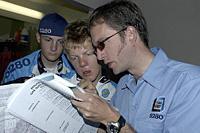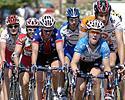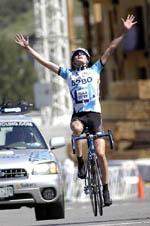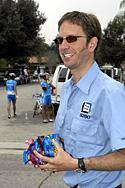
|
|
 |
 |
| |
 |
Team TIAA-CREF - 2005
Special News Feature, January 9, 2005
Jonathan Vaughters: The first year director
After launching the TIAA-CREF/5280 team in 2004, former Credit Agricole pro Jonathan Vaughters found himself in the enviable position of being the directeur sportif for the US development squad. His first year behind the driving seat was not without its problems, but he survived them and is now ready to tackle 2005 with less trepidation. Vaughters describes his year here in his own words - budding directors take note!

|
It dawned on me sometime in the registration line at the Redlands Classic, and as it did, I started sweating and wanting to leave. What dawned on me was that I had no idea of what the hell I was doing. I panicked to myself, thinking, "Man, I don't know how to register a team, drive in the caravan, and I have no idea how to find my way to the start of races."
You think that all those years as a rider will just convert into knowing what the hell to do as a director, but what I really learned was that I never paid attention to what my directors did all those years, and I had no clue how to do it myself. However, seeing as I how I had proclaimed myself the director of Team TIAA-CREF, I realized that I had better get busy learning.
Teething
Our first event of the year, Redlands, ran OK, if a bit hectic at times. We had quite a few crashes, and guys getting sick, which highlighted why this is a development team, and not quite a full fledged pro team just yet. It was also a big lesson in how much work goes into a team behind the scenes. As a rider you just always trust that you'll get to the start on time, your bottles will be clean, and your bike will work, but hoooweee, all of that takes quite a bit of doing when it's late at night and the riders are all asleep. Then when something really goes sideways, like someone crashing severely and being ambulanced to a hospital, it really emphasizes how much of a mad crazed scene cycling is behind closed doors.

|
In my case, my first lesson was when Sheldon Deeny crashed hard with David Zabriskie in the second stage of Redlands. It never felt so odd in my life to have to leave a rider flat on the road and go off to support the others, and simply just trust that the medical team at the race would take care of things. I stayed with Sheldon a good five minutes longer than any other team director that had a rider in this pileup. Most had just checked and then quickly sped off to support the race in front. I couldn't do that, it just grated on me. Eventually, I did take off in pursuit of our boys still upright, but man...
After the race finished up, we had to drive all the boys back to the hotel, and then figure out which hospital they had taken Sheldon to. You would think this would be apparent, but when there is a large crash, different riders can go to different hospitals. It was some 40 phone calls, and at least 10pm at night when we found where Sheldon was. The whole time we were searching for him I was just dreading having to make the phone call to his parents and say "Yes, Mrs Deeny, your son was in a very bad crash, and we have no idea if he's ok or not - we also can't find him, and he has no way home - but, sleep tight and we'll let you know in the morning." Luckily we found Sheldon, and other than about 200 stitches, he was OK.
"You can't always tell who's going to be a true champion just by how well they ride at 18 or 19."- Jonathan Vaughters takes a broad view when it comes to developing young riders |

|
Lessons learned from Redlands, the next race we found our way to was the Tour de Georgia. The boys were to race in a full fledged UCI 2.3, Lance Armstrong and all. And I was supposed to know what I was doing. This was, quite obviously, a few notches up in complexity and logistical problems from Redlands. Transfers every day, different hotels, towns, lost car keys and on and on. But I seemed to hold it together, if only getting two or three hours of sleep every night.
I was, in contrast, quite happy with how the boys rode at Tour de Georgia. It was a pleasure to see them able to hold their own with such high level competition. Well, for the most part they held their own... Ian Macgregor was the first rider, bar none, dropped, each and every day. He finally just got time cut, and that, as they say, was that. You might think to yourself that my job would be to yell at him to get busy training, or to give up cycling and get a real job. Quite clearly if you can't keep up even on a pan flat stage of the little Tour de Georgia, you don't have the goods to one day be a pro, right?

|
Well, lucky for Ian, he has me for a director. I was once the first guy dropped in every race. I was the guy who everyone thought needed to go back to school and become a doctor like my parents wanted. 6 yrs later I was the guy who won on Mt Ventoux. Point being, talent reveals itself in odd ways, and you have to look for it in different ways than just what a rider can do today. Riders develop in different ways and at different rates. You can't always tell who'd going to be a true champion just by how well they ride at 18 or 19. Young riders have huge ups and downs, and don't always know why, but the job for a director is to show absolute confidence in them, and their ability. You have to make your picks with riders and then stick by those picks, period.
This is not to say you should be easy on them, and let them just muddle around. You have to be hard on them, to reveal their errors, but not prejudice to what their future might be. Ian took until July to finally finish a complete stage race. He was written off by quite a few folks as a poor pick on my part, and too fragile to be any good.. Ian also later went on to become the US U23 Champion, and no-one seemed to remember he was the worst rider at all the Tour de Georgia or that the week before they wrote him off. But I remember, and so does he.
A director's worst nightmare

|
The other shocking event of neo-director apprenticeship at the Tour de Georgia was, sadly enough, another accident. During the time trial, one of my most talented riders, Craig Lewis, was hit by a car. I was following a different rider in the team car when I heard race radio announce that Craig had been hurt. When I arrived at the finish, I could see it was bad by the looks on the faces of the race directors.
I had been in many severe accidents in my long, and accident prone career as a cyclist, but I never felt emotion over it. Crashes happened and that was that. But this was much, much different. I was immediately very nervous upon hearing of his crash. Arriving at the hospital my gut just sank as the doctors told us that Craig was hanging on by a thread. I never felt overwhelmed in my life. I didn't know what to do, what to tell his parents. I kept thinking that if I'd followed Craig instead of Timmy it would not have happened. In just three shorts month of this team, we already had what would be the worst crash in all of cycling for 2004 within our ranks.
The list of injuries was worse than anything I've ever heard about and had the rider survive. Some 40 broken bones, 2 punctured lungs, a severe concussion, internal bleeding, and on and on. It was absolutely horrific. And there was Craig, tubes in his mouth to allow him to breath, blood everywhere, and only partially coherent. The first thing he did, unable to talk, was write on a small scrap of paper "ride?" He wanted to know when he could start training again. Unreal.
As a rider, when somebody crashes, you hate to hear about it, but you put it out of your mind, as you can't think about what could happen. As a director, you are responsible for these guys, and their safety, so when something happens, it touches you much, much deeper. I prayed for Craig and for his family, and as the night wore on, the news got better and better.
"Remember that name, Craig Lewis, you will read quite a bit about him in the coming years."- Vaughters has a lot of belief in his riders |
Craig's recovery was long and tough for him, both mentally and physically. He seemed determined and on the edge of giving up all at the same time. He wanted to race, but yet, he was scared of his return. I figured the best thing I could do was simply tell him I thought he'd have no problem making it back to where he was before if he wanted to, and that being patient would serve him. He was lonely, not being able to travel with the boys to races, and he was tired of all the surgeries he was going through. You could see too that the pressure of his very worried parents had him questioning whether to return to being a cyclist or not. I understood every reason Craig would not ever want to race a bike again. I also know that Craig Lewis is a name you will see at the very top of professional cycling in a few years.
So, as he went through the turmoil of his recovery, I simply tried to keep him updated as to how great the team was going to be next year, and how he was going to be an integral part of that. I didn't want him to rush back into racing, but he needed to do a few small events in 2004, just to get the feel back.
In June, just 9 weeks after the accident, Craig flew out to Colorado to visit me and his teammates at a little celebration for Colby Pearce, who had just made the Olympic team. I convinced Craig he should try a little, local Tuesday night training race held a little south of Denver. He acquiesced a bit tentatively, and rode out there, as I drove behind. It seemed a bit of a production to have someone follow you to just a little, local Tuesday night race, but I wanted to make sure Craig was OK, and make sure he got his feet wet with a little race, once again.
I was noticeably tense as the race started, as I knew if something went wrong, I would be blamed for pushing him back too soon. After 3 or 4 laps, there was Craig, with his stylish grace on the bike, having no problems riding in the peloton, and seemingly having fun. I was relieved, and knew, right then, that Craig would make a full comeback. Remember that name, Craig Lewis, you will read quite a bit about him in the coming years.
Bouncing back with success

|
Occasionally, things also go unbelievably right on a team too. Our redemption for all the tough times we had was at U23 National Championships. During our team meeting, despite protests from the guys, I put my foot down and told them the way to win was to attack from the start. This might seem an odd tactic for a U23 race of over 200km, but I had seen this type of event, and I knew that the bigger question, was who would chase from behind? We placed four riders in a break of 10, and completely dominated the race from the front and from the peloton. All of the team rode superbly, and 100% unselfishly, even Ian, who went on to win, never once rode outside the context of teamwork.
I really couldn't believe that I'd somehow convinced (or scared) a bunch of 19 and 20 yr olds into forming such a slick unit that day. But they came together and absolutely dominated. In reality our team finished 1st, 2nd and 3rd, as the 2nd place rider normally rides for us, but was riding for the National team on that day. I have never been so proud, and never so relieved, that things were starting to work the way they were supposed to!
All of these little incidents, errors, and victories just begin to scratch the surface of the multiplicity of functions a team director must serve. You must be a coach, a confidant, a mentor, a businessman, a friend, and a father all wrapped into one. It is, perhaps just like racing, one of the most complicated jobs you could have, although in a very different way. As a racer, you must be ultimately selfish in order to have a career. Everything must come second to racing. A director must be everything to everyone. It involves juggling personalities and elements from all walks of life, and melding them into a cohesive unit that not only performs in bike races, but serves its function as a marketing tool. The riders which, as I mentioned, must be innately selfish to survive high level cycling, must learn to be completely selfless in the context of a team. And it is the responsibility of the director to make this happen. Not an easy task by anyone's stretch of the imagination.
"A poker face is perhaps the greatest asset of a director."- Vaughters on the need to keep everyone happy |

|
All the pressures and money worries that chasing, and placating sponsors must be internalised, if you are to succeed in being a director. The business aspect of a team, and the day to day functions are interdependent, but yet must be separated. If the worry of anything non-race related reveals itself in the director, the confidence of the team is shaken and lost. In the same, if the pressures of getting race results reveal themselves to sponsors, their confidence is lost as well. A poker face is perhaps the greatest asset of a director.
As I head into 2005, Team TIAA-CREF has grown exponentially, and we have much to prove in 2005. But with our added clout and presence will come pressure and with pressure can come tension. However, that tension is what makes a good rider great, and what separates a team that rises to the occasion to one that folds under the weight of individualism and stress. Which makes my job very simple: keep all the balls in the air at once, like a juggler, and never stop smiling. Keeping the ball in the air will be hard, but I truly love the job, so the smile will come a bit easier.
(Note: Vaughters is planning a major launch of the 2005 team to be held in Colorado in February - full details to be published soon. For more information about Jonnthan Vaughters see www.jonathanvaughters.net.)
Also see: Team TIAA-CREF 2004